Watch Sales Guy Unplugged: Are Your Sales Questions Courageous Enough?
Mark Trinkle, Chief Growth Officer
Need more information? Download this free SalesTool with the Drill Down Questions.
Sales & Sales Management Expertise Blog
Watch Sales Guy Unplugged: Are Your Sales Questions Courageous Enough?
Mark Trinkle, Chief Growth Officer
Need more information? Download this free SalesTool with the Drill Down Questions.
Topics: things to do for sales success, how to improve sales, sales leads, create & convert leads
What does it take
Lead Generation Equation: Effort +Effectiveness = Leads
Hiring the right
But it’s not that simple. Every president and sales manager I’ve talked to over the last year, tell me that the biggest challenge their
If you’ve read my posts in the past you may have stumbled across one that talks about growing up on a blueberry farm in Hammonton, NJ. Little did I know at the time that my early life would help me better understand the world of selling. Growing up on a farm is about surviving. Our family survived season after season, year after year. We were never rich, never had extra money, were never able to save for a rainy day much less put money away in a retirement account. Surviving then (and probably now for most of those who work in farming) required three important skills and behaviors and discipline to be successful.
I assure you that none of the following three “lead generation and selling” activities were easy. These activities required a commitment to succeed, a not-an-option mindset, specific skill sets and a vow to do everything possible to succeed.
Growing sales requires
Today’s
When we assess sales talent within an organization or screen sales candidates, we help our clients minimize the high costs of hiring ‘ghosts' with findings in several important areas that help determine if the
Hunting
As you can see from the exhibit below, very specific skills are needed to be a successful hunter. A hunter must be able to get past “gatekeepers” to reach decision makers, attend networking events and consistently prospect.
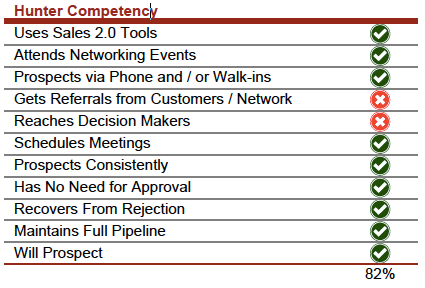
But look at all the ‘stuff’ that you may not have known are critical to generating enough leads. Generating leads today includes additional skills and aptitudes, as well as traditional people skills and aptitudes. Examples include: Uses sales 2.0 tools, gets referrals from customers/network, has no need for approval, WILL Prospect!
Topics: Prospecting, sales leads, generating leads, how to prospect, create & convert leads
We’ve been doing a fair amount of research into lead generation through our primary source, Hubspot. We’ve had a long business relationship with them because they provide a great platform for all things that are digital marketing and associated data. One thing we will begin to take better advantage of is their CRM application. This will allow us to tie our marketing efforts directly to a client management AND pipeline management system.
Why is this important? Because without a coordinated system that links marketing and sales:
How well
As you can see below the marketing area is where they are least aligned at 53%. This isn’t the end of the problem. We also asked all of the relationship managers (16) to write out the bank’s value proposition, brand
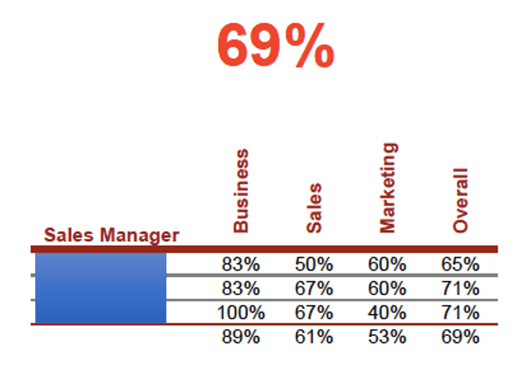
Overall results (not shown) indicate that less than 50% of the relationship managers in the group were able to express the value proposition with any consistency and only 25% responded with the correct brand promise. On the other hand, there was a 75% consistency in the elevator pitch.
Solutions:
The First Moment of Truth isn’t what it used to be. I’ve quoted this research before, The Zero Moment of Truth (
The first moment of truth for your sales people today
Solutions:
The world of buying has changed. It’s time to change the world of selling.
How well does your team measure against your industry? Assess your salespeople on the 21 core selling competencies.
Topics: sales prospects, sales leads, generating leads, how to prospect
At some
So, if you can handle the truth, here is the truth: selling has changed…but salespeople have not.
There are two significant changes that have swept over the sales landscape:
The first change brings to mind the 2011 Google eBook titled “ZMOT”. ZMOT is an acronym standing for the Zero Moment of Truth and is defined as the exact moment in the sales cycle that is between the stimulus (how the prospect became aware of a product) and the first moment of truth (a P&G term referring to the decision to make a purchase). In short, ZMOT refers to the point in time where the buyer is researching a product or service offering and the seller is completely unaware of the buyer’s actions.

Here is a quote from the Google book:
“If you’re available at the Zero Moment of Truth, your customers will find you at the very moment they’re thinking about buying, and also when they’re thinking about thinking about buying.” (ZMOT, 2011)
So, it all comes down to three simple questions:
It is inarguable that more and more buyers are finding and researching options online before they ever talk to a salesperson. Some estimates have YouTube doing 3,000,000,000 searches each month and uploading 100 hours of video every 60 seconds. And if they can’t find you…when they are looking for you…even if you don’t know they are looking are for you…. you are losing the Zero Moment of Truth.
As Colonel Jessup would ask “We live in a world full of prospects…who’s going to call them? You? They may have already passed their Zero Moment of Truth."
Topics: sales prospects, sales leads, generating leads, increase sales leads,, how to prospect
In the last 30 days, I’ve talked to more than a dozen company executives, sales

There is further validation of the current finding:
During training discussions over the course of more than 20 years, I’ve asked sales executives, presidents and sales teams to complete the following statement: I (we) would sell more, be more productive, more effective if only I (we) … The #1 most common answer consistently over the years has been “If I had more / better prospects to call on.”
In order to address the problem of
Let me use an example to explain. We are currently working with a financial institution that is hiring a new private banker in an expanded market. Using the pre-hire assessment from our partner Objective Management Group, we created a ‘tailored fit model’ based on the performance of the top and bottom current private bankers and then assessed the 5 candidates they were still considering.
Take a look at these findings:
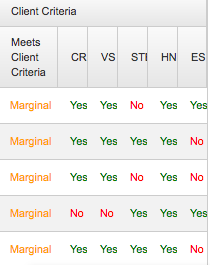
Figure 1 – How well did the candidates match the clients’ work history criteria for success? The client created a profile that indicated that the non-negotiable sale success criteria
But when we look at the other findings, we find the 3 challenges most common to organizations that are trying to consistently
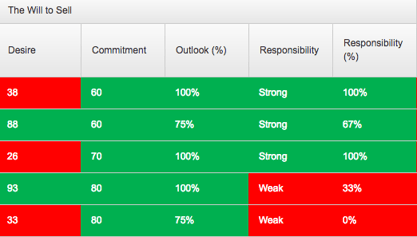
Figure #2 -When we look at Challenge #1 – ‘Will to Sell’ we find the following:
Only 1 candidate meets all the criteria for Will To Sell. The question becomes: How important is the will to sell when attempting to overcome the challenges of finding qualified prospects to talk to? If 1/3 of your current team lacks the will to sell what is the likelihood - despite all the ‘prospecting’ training you provide them – that they will actually execute? Also note that one of the candidates with strong desire, commitment and outlook will still be prone to making excuses for not prospecting, asking for introductions and networking. (Desire for Sales Success)
Figure #3 – Sales DNA (Sales DNA Audio) findings for the 5 candidates looked like this:
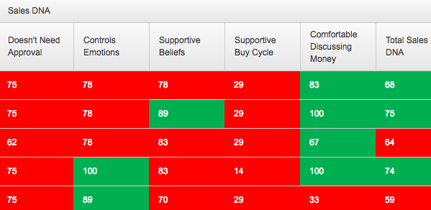
This post won’t go into the definitions of all the criteria you see here but understand that green is good and red is not so good. If you look to the right of the graph and look at the Total Sales DNA the scores in green and red told our client what they needed to know. If everything else is equal in the equation then your people with strong sales DNA are more likely to do the activity of prospecting and will be more successful.
*Candidate #2 meets the criteria of the client, has a very strong will to sell and has the highest sales DNA score. How many of the people on your sales team measure up to this ‘elite’ candidate?
The world of selling is certainly different today than it was just 5 years ago. Your prospects in the market place have more ways to find more information about you, your products and services. They have more ways to compare you against your competition and all of this happens without you or your sales people even making contact. (See ZMOT – Google Research – Zero Moment of Truth).
To meet the challenges of today, you need a sales team with the right stuff.
Topics: Prospecting, sales goals, sales prospects, qualified leads, sales leads, generating leads

Anthony Cole Training Group has been working with financial firms for close to 30 years helping them become more effective in their markets and closing their sales opportunity gap. ACTG has mastered the art of using science-based data and finely honed coaching strategies to help build effective sales teams. Don’t miss our weekly sales management blog insights from our team of expert contributors.
Anthony Cole Training Group, LLC